Jeongseon is a wonderful place to visit in any season, but its true charm is best revealed during winter. You can marvel at the pristine snowy landscape in glistening contrast to the abandoned black coal yards, and trek along a scenic path while admiring the fluffy white clouds above.
If it weren’t for Jeongseon County in Gangwon Province, Korea may never have embarked on its extraordinary economic development. The area’s significant role in Korean history can be said to have started with a gathering of government officials for the opening ceremony of Hambaek Station on March 9, 1957. They included Minister of Transportation Lee Jong-rim and Minister of Commerce and Industry Kim Il-hwan, who were joined by U.S. Ambassador Walter C. Dowling and Taiwanese Ambassador Wang Dongyuan. Why would foreign dignitaries attend the opening of a railroad station in a remote rural area? Evidently, the event was a transformational milestone.
COAL INDUSTRY HUB
The Hambaek Line transported Jeongseon residents across the expansive Gangwon Province, bordering the East Sea and North Korea. But its primary purpose was moving coal. In a country that doesn’t produce a drop of oil, coal was essential to powering Korea’s postwar recovery and rapid industrialization, while also keeping the lights on and providing heat to get through harsh winters. Between the 1950s and the 1980s, Jeongseon’s mines were Korea’s largest supplier of coal.
During its heyday, Jeongseon had as many as 36 coal mines, including the Dongwon Coal Company’s Sabuk Mine, the nation’s largest private mine at the time. The county enjoyed unprecedented prosperity owing to the nation’s insatiable demand for coal. Korea’s “golden taxi route,” the most profitable for drivers, was in the town of Sabuk in Jeongseon. An electronics store in Jeongseon recorded the highest sales in the country, and people joked that, “In Jeongseon, even dogs roam the streets with 10,000 won bills in their mouths.”
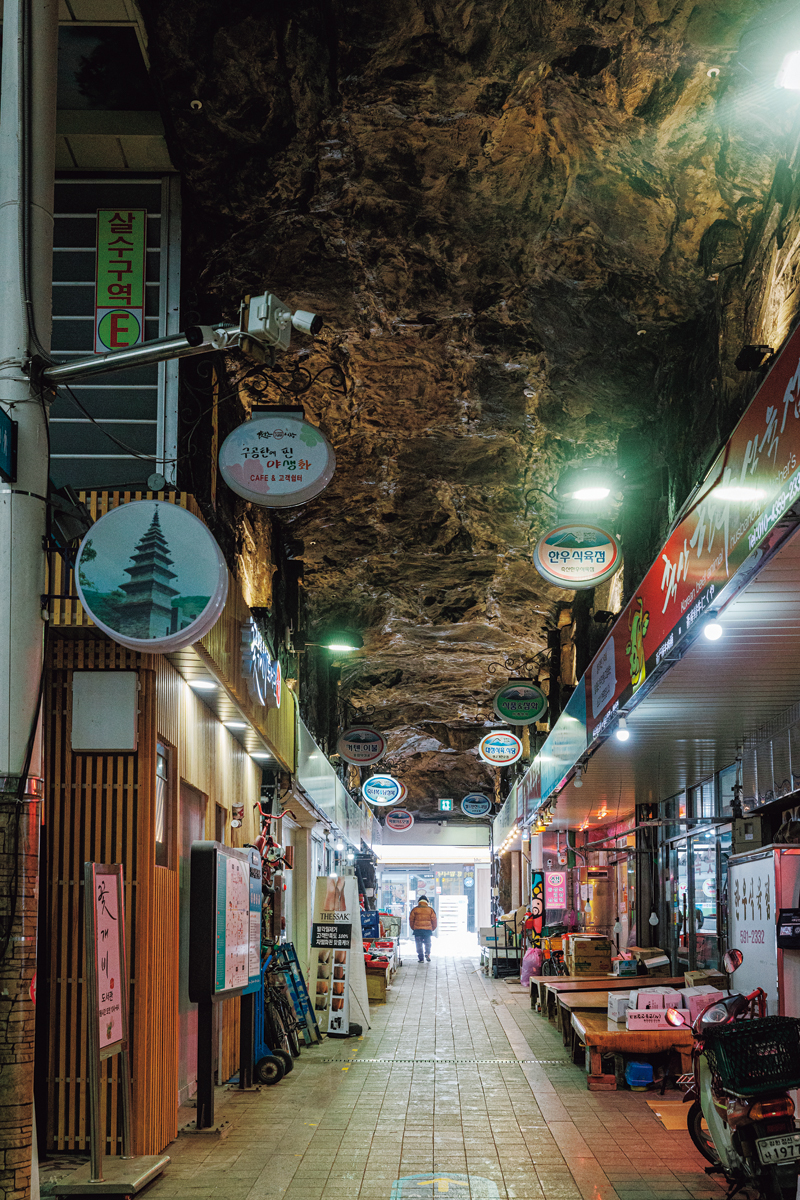
Gugongtan Market is named after a coal briquette with nine holes. On display in various corners of the market are art works themed on coal briquettes and miners.
However, things took a dramatic turn in the latter half of the 1980s. Amid stabilized oil prices and unabated increases in mining costs, demand for coal was expected to shrink, so the government introduced the Coal Industry Rationalization Policy, hoping to persuade the owners of unprofitable mines to cease operations. During the 1990s, most of the 347 coal mines across the country shut down. Among the few that held on, the Jangseong Mine in Taebaek, Korea’s biggest coal mine, finally closed in September of this year, and the Dogye Mine in Samcheok is set to close in 2025. That leaves only one privately run mine in the country, the Kyungdong Mine in Samcheok.
NEW LEASE ON LIFE
The closures, however, did not make coal mines a footnote in history. By turning crisis into opportunity, mining sites left abandoned in the wake of the industrial transition were successfully transformed.
Samtan Art Mine is a prime example of a coal mine reborn. The art and culture complex was established in 2013 at the site of Samcheok’s Jeongam Mine, where over 3,300 miners had extracted coal for 38 years, from the first swinging of a pickaxe in 1964 until the mine’s closure in 2001. Here the artworks are juxtaposed against vestiges of the old mine, which have been preserved to the greatest extent possible.
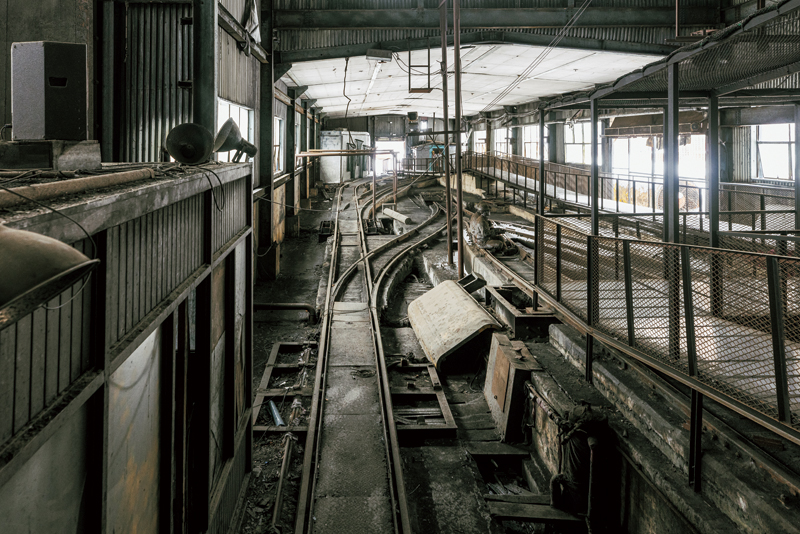
Samtan Art Mine is an art and culture complex transformed from an abandoned coal mine.
It was established at the site of Samcheok’s Jeongam Mine, which operated from 1964 to 2001.
The tour of the complex starts at Samtan Art Center, formerly the coal mine’s general office. The space that was once the communal shower room is jaw-dropping for its sheer size and was able to accommodate more than a thousand miners at once. Showerheads were installed on the ceiling to spray water in four directions. Now, contemporary art and photography works are displayed beneath them. In one section is an exhibition of photographs featuring miners who, until recently, were extracting coal in other mines.
The room where the miners cleaned their blackened boots, the laundry room for washing their overalls, and the main control room where the mechanical equipment was operated have all been turned into galleries. The blend of old and new, industrial facilities and works of art, creates a special ambience. There is also a museum displaying mining tools, old photographs, and other materials, attesting to the mine’s glorious past.
Behind the art center is the Rail by Museum, which houses a massive 53-meter-high steel tower visible from the entrance of the Samtan Art Mine. Inside the tower are two vertical mine hoists, used to lift extracted coal to ground level or take miners up and down the mine shaft. It once could transport four hundred miners at a time and twenty tons of coal every four minutes.
Directly below the hoist is a mine shaft that is so dark that it’s hard to fathom the depth. According to the curator, it goes down a staggering 653 meters. For comparison, Lotte World Tower in Seoul, the tallest building in Korea, and the Eiffel Tower in Paris are 555 and 330 meters tall, respectively. Standing in front of the shaft, you can almost feel the tremendous geothermal heat and humidity, and the endless fear that the miners had to endure. Their dangerous and hazardous underground labor helped build the foundation of modern Korea.
The conveyor and mine tubs, which still look as if they might move along the rails at any minute, and the shaft’s steel structure and steel rope all retain their original appearance. The Rail by Museum is rather awe-inspiring, like a colossal work of art that gives visitors a feel for how the miners suffered as they toiled deep underground.
Another old mine undergoing a similar transformation is the Sabuk Mine. Construction at the site is underway, with the Sabuk Coal Mine Culture Park scheduled to open in the first half of 2025.
BREATHTAKING TREKKING
While the Samtan Art Mine and Sabuk Coal Mine Culture Park are places where the mining heritage converges with art and culture, Untan Godo is where this heritage can be experienced amid the splendor of nature.
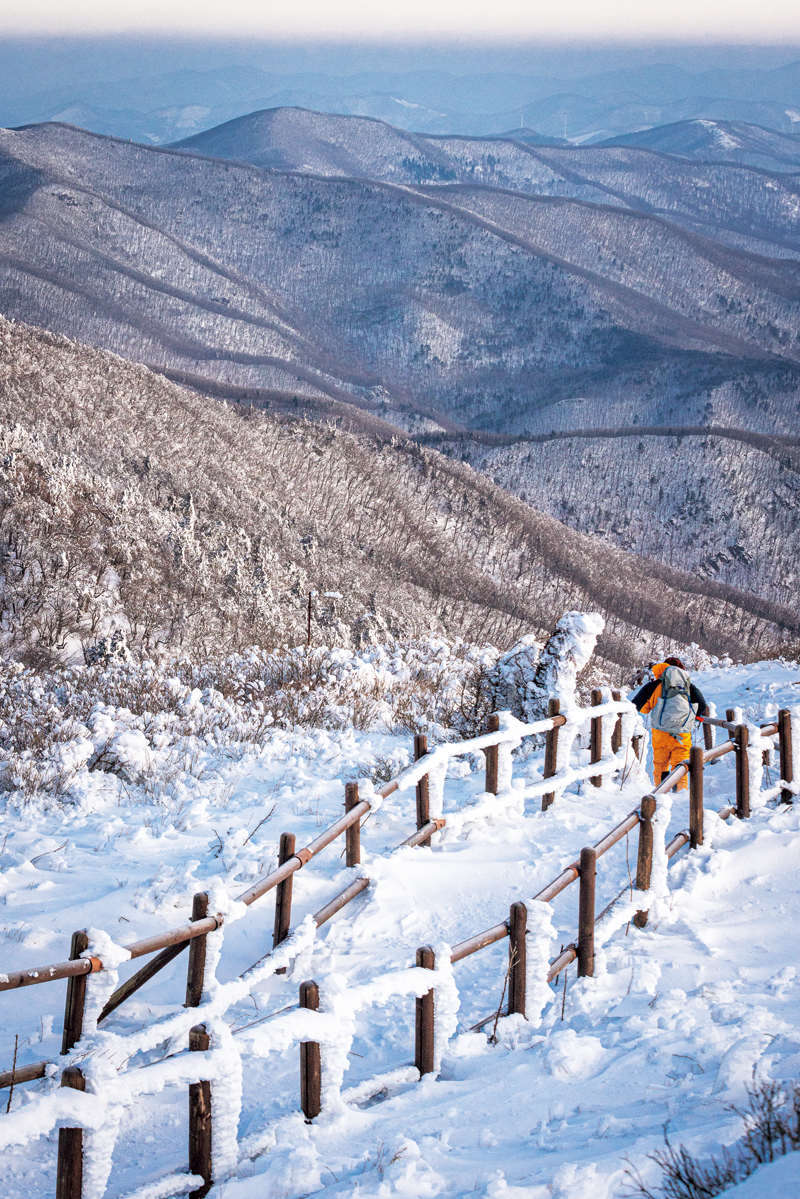
Mt. Hambaek is a popular winter trekking destination.
Untan Godo is a mountain road that was built to transport coal. With an average altitude of 546 meters above sea level, the highest point is Manhangjae, a pass at 1,330 meters above sea level, hence the road’s official name — Untan Godo 1330.
Untan Godo stretches over 173 kilometers, from Yeongwol County to the west of Jeongseon, passing through Jeongseon and Taebaek, and extending to Samcheok on Korea’s eastern coast. Along the road, there are nine trekking routes, the main and most popular ones being Nos. 4 and 5, which traverse Jeongseon. Remnants of the old coal transport road have been well preserved here, and with the adoption of the policy to phase out coal production, the desertion of the area has allowed nature to recover at a faster pace.
Route 4, stretching 28.76 kilometers from Yemi Station in Jeongseon to Kkotkkeokkijae, is a particularly beautiful trail offering breathtaking scenic views. The Time Capsule Park on Saebijae is famous for the pine tree featured in the 2001 rom-com My Sassy Girl, starring Gianna Jun and Cha Tae-hyun. The route takes about nine and a half hours to climb, with the elevation steadily rising from 403 meters to 1,197 meters.
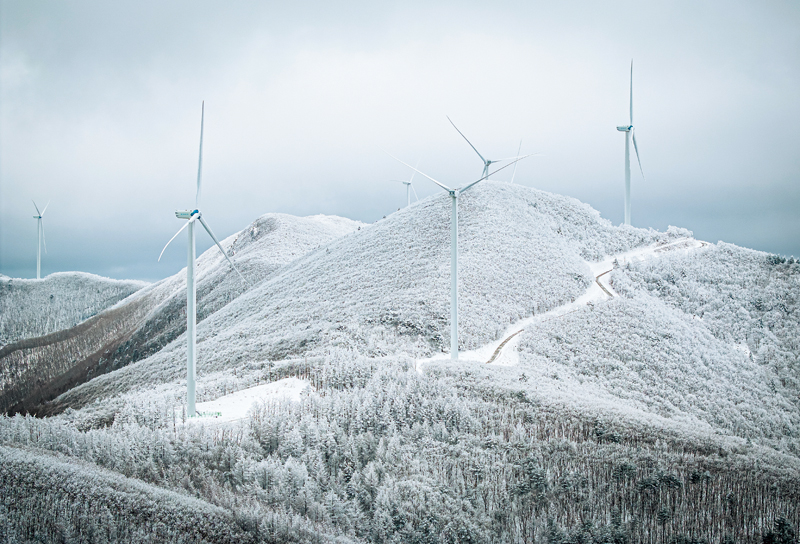
Manhangjae, a pass on Mt. Hambaek, is the highest point in Korea accessible by car. Visitors can enjoy the pristine snowy landscape without having to make the strenuous climb.
Route 5 extends from Kkotkkeokkijae to Manhangjae. The salamander pond that appears as soon as you pass Kkotkkeokkijae was formed when the ground sank due to underground mining in the 1970s. It is said that the wives of miners prayed to the salamanders in the pond for the safe return of their husbands. The story stemmed from the belief that if the pond water drained, the mine shaft had either flooded or collapsed, and neither the salamanders nor miners would be safe. Route 5 is 15.7 kilometers long and takes about six hours at a leisurely pace. From the 1,067-meter starting point to Manhangjae at 1,330 meters, the highest point in Korea accessible by car, the elevation fluctuates as it gradually rises. The trek may appear strenuous, but you will soon find yourself walking without much difficulty as you admire the stunning scenery.
Unlike most trekking trails, all those at Untan Godo have gentle slopes and flat surfaces, because they were not initially developed for trekking but to accommodate large trucks transporting coal. They now make a great destination for mountain runners and mountain bikers, and in winter, it’s even possible to enjoy sledding or Nordic skiing there. The road is also popular among backpackers who set up camp on the large, open areas along the trails.
In the past, the coal dust scattering in the wind on clear days would turn the sky and ground black, while on rainy days, the roads turned into mud making it impossible to walk without boots. Untan Godo has since been transformed into a set of beautiful trails, which are particularly enchanting when a white winter wonderland unfolds with clouds floating above.
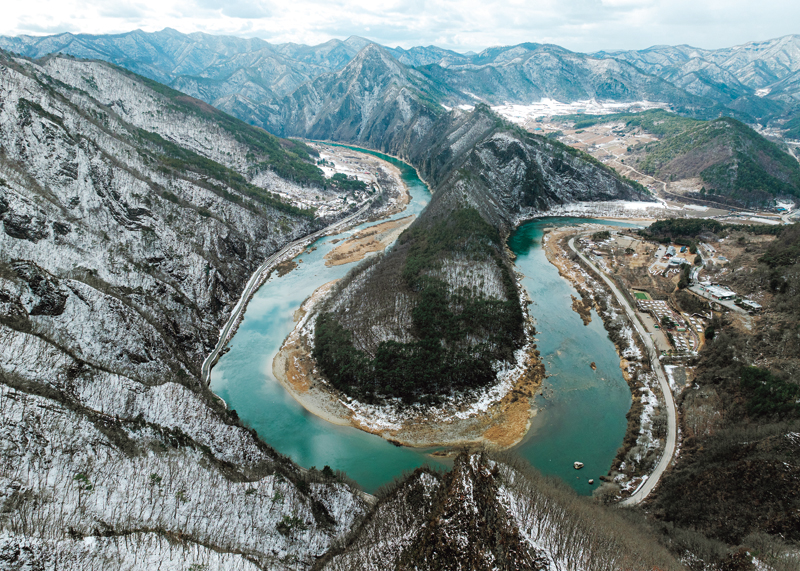
Byeongbangchi Observatory offers spectacular views of the Dong River flowing around a finger of land shaped like the Korean peninsula.
Kwon Ki-bong Writer
Shin Jung-sik Photographer